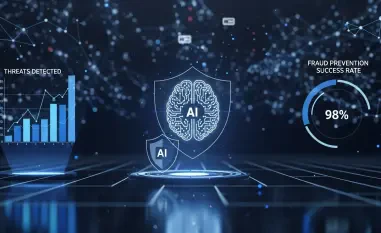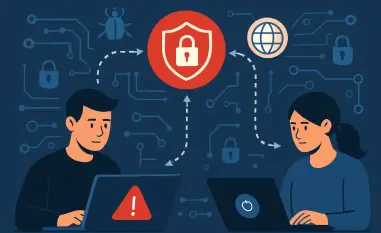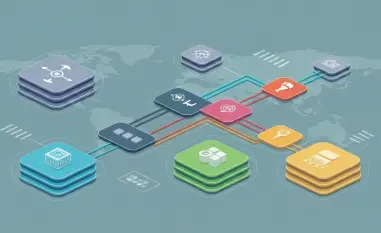The Evolving Cybersecurity Landscape for US Businesses
Imagine a scenario where a single data breach in a mid-sized US manufacturing firm cascades through its supply chain, halting operations for major clients in healthcare and technology, costing millions in downtime and reputational damage. This is not a distant possibility but a stark reality in 2025, as cybersecurity has become a cornerstone of business survival across sectors like manufacturing, financial services, healthcare, and technology. The rapid pace of digital transformation has amplified the importance of protecting sensitive data and infrastructure, making robust security measures indispensable for maintaining trust and operational continuity in an increasingly interconnected economy.
The scope of challenges facing US businesses is vast, driven by the integration of artificial intelligence (AI) and the proliferation of connected devices. Threats such as ransomware, phishing, and insider risks have evolved alongside technological advancements, with attackers leveraging AI to craft sophisticated campaigns that bypass traditional defenses. Digital expansion into cloud environments and remote work ecosystems further complicates the threat landscape, exposing new vulnerabilities that demand adaptive strategies to mitigate risks effectively.
Key market players, including leading cybersecurity solution providers like Palo Alto Networks, CrowdStrike, and Cisco, are at the forefront of innovation, delivering tools for threat detection and response. Meanwhile, technology innovators are pushing boundaries with AI-driven security platforms. Government and regulatory bodies are also exerting growing influence through policies and frameworks that mandate stringent security standards, shaping how businesses prioritize and implement protective measures in a dynamic environment.
Key Trends and Market Dynamics Shaping 2026
Emerging Technologies and Threat Vectors
As US businesses navigate the digital frontier, emerging technologies are redefining both opportunities and risks. AI is increasingly adopted for threat detection and response, automating processes to identify anomalies in real time and reduce response times significantly. However, the rise of quantum computing looms as a potential risk to current encryption methods, necessitating early preparation for quantum-safe solutions to protect sensitive data in the coming years.
Beyond technological shifts, consumer expectations for data privacy and security are intensifying, pushing companies to prioritize transparency and robust safeguards. Market drivers such as digital expansion and interconnected supply chains further heighten the stakes, as vulnerabilities in one link can compromise entire networks. These dynamics underscore the urgency for businesses to stay ahead of evolving threats through proactive investment in cutting-edge defenses.
Amid these challenges lie opportunities for differentiation. Companies that innovate in cybersecurity—whether by integrating advanced AI tools or adopting privacy-first approaches—can build trust with customers and partners, positioning themselves as leaders in a crowded market. Leveraging security as a competitive edge not only mitigates risks but also opens doors to new business prospects and strengthened stakeholder relationships.
Market Growth and Future Projections
The cybersecurity market is experiencing unprecedented growth, with spending projected to surge as businesses ramp up defenses. Recent data indicates that a significant portion of US enterprises—approximately 78% as of this year—have integrated AI tools into their security operations, a trend expected to expand through 2026. This adoption reflects a broader push toward automation and efficiency in combating sophisticated threats across critical sectors like finance and healthcare.
Looking ahead, forecasts suggest robust market expansion, with heightened demand for skilled talent and advanced technology adoption driving investment. Federal contract requirements are also tightening, mandating higher cybersecurity standards for vendors, particularly in defense and infrastructure. Between 2025 and 2027, sectors such as technology and government are anticipated to lead in expenditure, fueled by the need to protect against escalating cyber risks and comply with evolving regulations.
Investments in cybersecurity are increasingly viewed as a strategic asset, yielding measurable returns through cost avoidance and enhanced market positioning. Businesses that allocate resources to risk-based security initiatives can sidestep the financial fallout of breaches while gaining a reputation for reliability. This forward-looking approach positions firms to capitalize on growth opportunities while fortifying their defenses against future uncertainties.
Critical Challenges Facing US Businesses
The path to cybersecurity resilience is fraught with obstacles, chief among them a persistent talent shortage that hampers organizational capacity. With demand for skilled professionals outstripping supply, many companies struggle to fill critical roles, leaving gaps in their defense mechanisms. Addressing this shortfall requires innovative solutions like automation to reduce manual workloads and strategic partnerships to access shared expertise.
Supply chain vulnerabilities present another formidable challenge, as interconnected networks amplify the impact of a single breach. The risks of ungoverned AI usage further complicate matters, with unapproved tools potentially exposing sensitive data or violating compliance standards. Technological hurdles, such as preparing for quantum computing threats, alongside market pressures like rising breach costs and insurance premiums, add layers of complexity to an already demanding landscape.
To navigate these issues, businesses can adopt continuous monitoring for supply chain security, ensuring real-time visibility into potential risks. Proactive governance frameworks are essential to manage AI-related vulnerabilities, while automation offers a practical means to bridge workforce gaps. By prioritizing these solutions, companies can build a more resilient posture, mitigating the impact of both current and emerging threats.
Navigating the Regulatory and Compliance Environment
The regulatory landscape for cybersecurity in the US is intricate, with federal frameworks setting rigorous standards for businesses, especially those engaged with government contracts. The Cybersecurity Maturity Model Certification (CMMC 2.0) imposes tiered requirements to safeguard sensitive information, while National Institute of Standards and Technology (NIST) guidelines provide a blueprint for risk management across industries. Compliance with these standards is non-negotiable for maintaining eligibility in federal partnerships.
State-level data privacy laws add further complexity, particularly for companies operating across multiple jurisdictions. The California Consumer Privacy Act (CCPA), for instance, enforces strict consumer data protections, impacting how businesses handle personal information. This fragmented regulatory environment demands a cohesive approach to compliance, ensuring that policies align with both state and federal mandates to avoid legal pitfalls.
Integrating compliance into data governance strategies is critical for business continuity and risk mitigation. A unified framework that embeds regulatory requirements into daily operations can streamline adherence while reducing exposure to financial penalties. Such an approach not only safeguards against legal challenges but also reinforces trust with stakeholders by demonstrating a commitment to ethical data management.
Future Outlook: Innovations and Opportunities Beyond 2026
Looking beyond the immediate horizon, the cybersecurity field is poised for transformative advancements driven by emerging technologies. Quantum-safe encryption is gaining traction as a solution to future-proof data against quantum threats, while Secure by Design principles are becoming a standard, embedding security into product development from the outset. These innovations signal a shift toward proactive rather than reactive defense mechanisms.
Potential disruptors, such as AI-driven attacks and geopolitical tensions, loom as significant factors that could reshape the threat landscape. Simultaneously, consumer demands for transparency and stringent security are expected to intensify, compelling businesses to adapt swiftly. Staying ahead of these shifts requires vigilance and a willingness to embrace new methodologies to protect critical assets.
Growth areas are emerging through ecosystem-wide risk management, where industry collaboration plays a pivotal role. Strategic investments in resilience and innovation, coupled with shared threat intelligence initiatives, can enhance collective security across supply chains and partnerships. By fostering such cooperative efforts, businesses can unlock opportunities to strengthen their defenses while contributing to broader industry stability.
Building a Resilient Cybersecurity Strategy
Reflecting on the insights gathered, it becomes evident that cybersecurity has transcended its role as a mere compliance necessity, emerging instead as a strategic asset for US businesses. The exploration of trends, challenges, and regulatory demands underscores the transformative potential of security investments in driving competitive advantage. Each facet of the discussion highlights how proactive measures fortify organizational resilience against a backdrop of escalating threats.
Moving forward, actionable steps emerge as a priority for sustained progress. Businesses are encouraged to channel resources into risk-based investments, targeting high-value assets for maximum protection. Fostering workforce development through continuous education and automation proves essential to overcoming talent shortages, while adopting collaborative defense mechanisms with industry peers offers a pathway to bolster supply chain security.
Ultimately, the journey toward 2026 reveals a landscape ripe with potential for those who embed cybersecurity into their core strategies. By aligning security initiatives with broader business goals, companies lay the groundwork for not only mitigating risks but also seizing market opportunities. This strategic integration promises to redefine success, ensuring that resilience and innovation remain at the forefront of corporate priorities.













